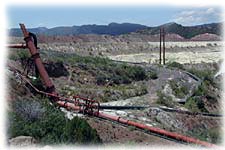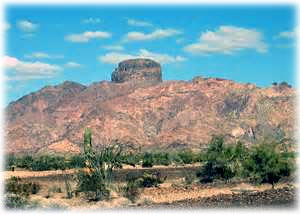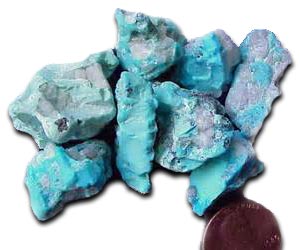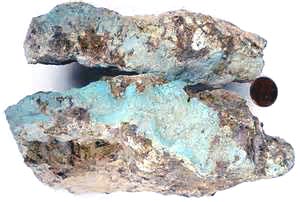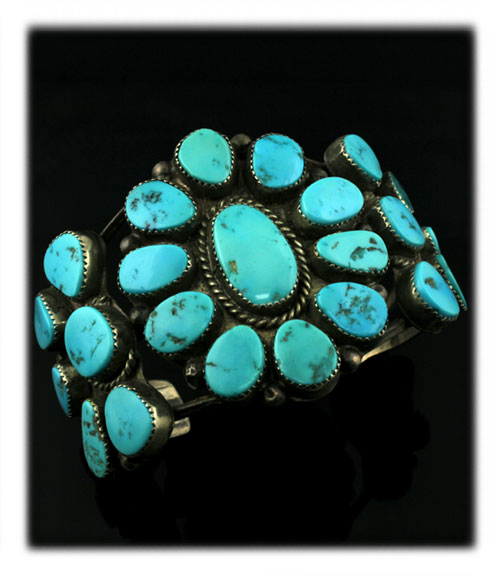 Loading... Please wait...
Loading... Please wait...- 970-759-1040 Text / Voice
- Gift Certificates
- My Account
Currency Displayed in
Categories
Castle Dome Turquoise
Castle Dome Turquoise
Learn About Castle Dome Turquoise
|
Castle Dome Turquoise Mine
|
Castle Dome Turquoise or Pinto Valley Turquoise is one of the American Turquoise classics. The baby blue Turquoise from the Castle Dome mine in Arizona was widely used in Vintage Turquoise Jewelry by Native American Jewelry artisans as well as Anglo and Latino jewelry artisans. Between the 1940's and 1980's the mine supplied much of the Turquoise used in Zuni Jewelry and Navajo Jewelry. You will find a ton of Castle Dome Turquoise in old pawn jewelry, especially in the cluster, Zuni needle point jewelry, and Zuni petite point jewelry. Castle Dome (1943) and Pinto Valley (1972) are located five to eight miles west of Miami in Gila County, along the south slopes of the Porphyry Mountains. Large quantities of copper and Turquoise have been produced from these areas. Many old-time lapidaries did not like to cut this Turquoise because it had so many fractures in its structure, which might have been brought about by the blasting techniques that were used when it was mined. The mine produced all grades of Turquoise and did produce a lot of "Chaulk Turquoise" as is common with gemstone opperations associated with large metal mining operations. The high-grade material that was produced consisted of a beautiful bright and sometimes deep blue turquoise. |
|
Castle Dome Turquoise, which has also been known as Pinto Valley, is a by-product of a copper mine located five to eight miles west of Miami, Arizona. Much of Arizona Turquoise comes from the copper mining operations, which are often continuations of old Turquoise mines. The Castle Dome mine was originally opened in 1943 and developed by the Anglo miners as a war project. With the end of War World II and a low demand for copper the mine closed in 1953. Later the area was re-opened as the Pinto Valley Mine. Turquoise was widespread throughout with masses over one-half inch thick with colors ranging from sky-blue to bluish-green with the blue color being predominate. Early on employees of the mine were permitted to dig the Turquoise on their days off. Large quantities of the mineral were purchased by dealers in the Globe and Miami areas. Later, the Turquoise concession was leased out to an individual who then marketed the material thoughout the world. This was a large producing mine though little Turquoise was of the high-grade quality. Most of the grades of Turquoise were sent out for treatment. In the 1970's this area was considered Arizona's second largest producer of Turquoise. According to the "Turquoise Annual" volume 2." About 9,000 pounds of turquoise are collected each month by the mine's lessee, L.W. Hardy, who also leases Mineral Park Mine near Kingman." For this reason you can see why there is a lot of natural and treated Castle Dome Turquoise in Old Pawn Indian Jewelry. Castle Dome is probably one of the most predominant Arizona Turquoise in Southwestern Jewelry. You will find blue and green Turquoise from this mine in a lot of old cluster jewelry and Zuni Jewelry. |
Gem Grade Rough Castle Dome Turquoise
Low Grade Castle Dome Rough |
Castle Dome Turquoise
Here is some of the geological information we found about Castle Dome Turquoise written and edited from an article by the American Minerologist:
|
Old Navajo Cluster Bracelet with Natural Castle Dome Turquoise from Arizona |
Turquoise, CuO·3Al2O3·P2O5·H2O.--Turquoise is fairly widespread throughout the chalcocite zone and in the leached capping. A hard variety of gem quality occurs in small veinlets up to one-quarter inch thick and also in concretion-like masses up to one-half inch thick and several inches across. Its color ranges from sky-blue to bluish-green, the blue variety predominating. It is generally associated with clay minerals and sericite which form selvages on the veins and masses and are commonly included in the Turquoise. Seen under the microscope; it it is a microcrystalline aggregate having a mean index of refraction of 1.62. Turquoise is generally conceded to be a supergene mineral, formed by the action of ground-water solutions, carrying copper and phosphate ions, on kaolin and possibly sericite. Various writers describe all stages in the alteration from copper-stained kaolin to hard Blue Turquoise; but it is not usually clear from the published descriptions whether the mineral is kaolinite or some other clay. Kaolinite is not a common mineral in theCastle Dome deposit, and its association with Turquoise has not been noted; however, Turquoise is commonly associated with beidellite, halloysite, and sericite. No evidence has yet been found suggesting that it forms from clay. The hard blue Turquoise grades into the soft, white clay-like variety; but the index of refraction of all of it is near 1.62, which is much higher than that of any of the clays present. None of the material could be construed as being transitional between turquoise and the associated clay. |
|
Although Castle Dome Turquoise is most abundant in the upper part of the secondary sulfide zone, it is commonly found in deep fractures where chalcopyrite is only slightly replaced by chalcocite or not at all. If Turquoise in the Castle Dome deposit was formed by supergene solutions, the phosphate ion would have to be derived from either wavellite or apatite which are the only earlier phosphate minerals. Wavellite is apparently dissolved by supergene solutions, but much turquoise occurs in parts of the mine where no wavellite has been recognized. In the Castle-an-Dinas mine in Cornwall,15 wavellite spheres are commonly covered by minute botryoidal aggregates of bright-green Turquoise, but no such association has been seen in the Castle Dome Turquoise deposit. Most writers look to apatite as the probable source of phosphate ion even though admitting in some cases that the country rock contains very little apatite. |
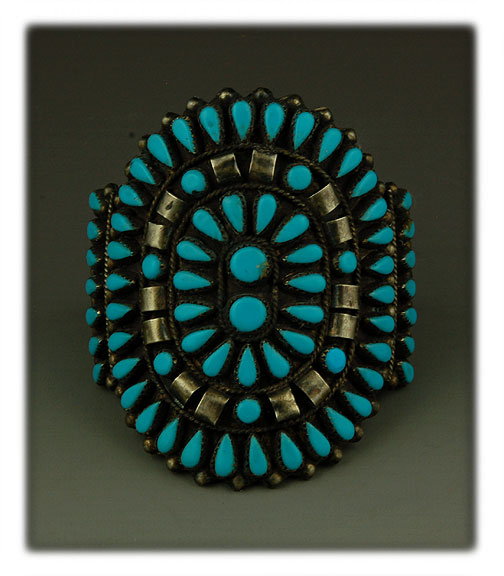 |
Also, join our Newsletter below as we put out a mailing with more information on Turquoise, Turquoise Jewelry, gemstone silver jewelry and what's going on with our company and the Southwest Jewelry industry. We hope you have learned a little about Castle Dome Turquoise.




